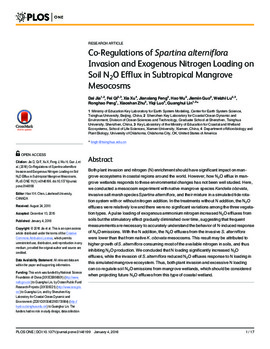| dc.contributor.author | Dai Jia | |
| dc.contributor.author | Fei Qi | |
| dc.contributor.author | Xia Xu | |
| dc.contributor.author | Jianxiang Feng | |
| dc.contributor.author | Hao Wu | |
| dc.contributor.author | Jiemin Guo | |
| dc.contributor.author | Weizhi Lu | |
| dc.contributor.author | Ronghao Peng | |
| dc.contributor.author | Xiaoshan Zhu | |
| dc.contributor.author | Yiqi Luo | |
| dc.contributor.author | Guanghui Lin | |
| dc.date.accessioned | 2017-03-04T01:59:50Z | |
| dc.date.available | 2017-03-04T01:59:50Z | |
| dc.date.issued | 2016-01-04 | |
| dc.identifier.citation | Jia D, Qi F, Xu X, Feng J, Wu H, Guo J, et al. (2016) Co-Regulations of Spartina alterniflora Invasion and Exogenous Nitrogen Loading on Soil N2O Efflux in Subtropical Mangrove Mesocosms. PLoS ONE 11(1): e0146199. doi:10.1371/journal.pone.0146199 | en_US |
| dc.identifier.uri | https://hdl.handle.net/11244/49230 | |
| dc.description | We thank Zhonglei Wang, Cunxin Ning, Hui Chen, Qian Huang, Fang Liu and Jian Zhou for their assistance with the greenhouse experiments and gas sampling. We are also grateful to Weimin Song, Rashid Rafique, Junyi Liang, Zheng Shi and Jianyang Xia for editing the manuscript. | en_US |
| dc.description | | en_US |
| dc.description.abstract | Both plant invasion and nitrogen (N) enrichment should have significant impact on mangrove ecosystems in coastal regions around the world. However, how N2O efflux in mangrove wetlands responds to these environmental changes has not been well studied. Here, we conducted a mesocosm experiment with native mangrove species Kandelia obovata, invasive salt marsh species Spartina alterniflora, and their mixture in a simulated tide rotation system with or without nitrogen addition. In the treatments without N addition, the N2O effluxes were relatively low and there were no significant variations among the three vegetation types. A pulse loading of exogenous ammonium nitrogen increased N2O effluxes from soils but the stimulatory effect gradually diminished over time, suggesting that frequent measurements are necessary to accurately understand the behavior of N-induced response of N2O emissions. With the N addition, the N2O effluxes from the invasive S. alterniflora were lower than that from native K. obovata mesocosms. This result may be attributed to higher growth of S. alterniflora consuming most of the available nitrogen in soils, and thus inhibiting N2O production. We concluded that N loading significantly increased N2O effluxes, while the invasion of S. alterniflora reduced N2O effluxes response to N loading in this simulated mangrove ecosystem. Thus, both plant invasion and excessive N loading can co-regulate soil N2O emissions from mangrove wetlands, which should be considered when projecting future N2O effluxes from this type of coastal wetland. | en_US |
| dc.language.iso | en_US | en_US |
| dc.publisher | PLos One | |
| dc.relation.ispartofseries | PLoS ONE 11(1): e0146199 | |
| dc.relation.uri | http://www.plosone.org/article/info%3Adoi%2F10.1371%2Fjournal.pone.0146199 | |
| dc.rights | Attribution 3.0 United States | |
| dc.rights.uri | https://creativecommons.org/licenses/by/3.0/us/ | |
| dc.subject | Mesocosms,Mangrove swamps,Wetlands,Tides,Invasive species,Nitrification,Sea water,Sediment | en_US |
| dc.title | Co-Regulations of Spartina alterniflora Invasion and Exogenous Nitrogen Loading on Soil N2O Efflux in Subtropical Mangrove Mesocosms | en_US |
| dc.type | Research Article | en_US |
| dc.description.peerreview | Yes | en_US |
| dc.description.peerreviewnotes | http://www.plosone.org/static/editorial#peer | en_US |
| dc.identifier.doi | 10.1371/journal.pone.0146199 | en_US |
| dc.rights.requestable | false | en_US |

